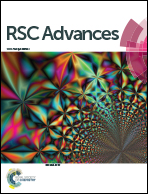Investigations on biodegradable polyurethane nanomaterials with different EDTA-diol content in the soft chain
Abstract
Novel biodegradable multi-block polyurethanes have been prepared by using EDTA-diol and poly(1,4-butylene adipate glycol) (PBA) as the soft chain, and 1,4-butanediol and hexamethylene diisocyanate as the hard chain. The resulting amphiphilic PUs can self assemble in water to form uniform nanospheres or nanotubes. The effect of both the EDTA-diol content in the soft chain and the hard chain content of the prepared PUs on the morphology of the nanospheres or nanotubes is extensively investigated by means of fluorescence spectrometer and transmission electron microscopy. The results show that the morphology of the PU nanoarchitectures can be facilely controlled by changing the EDTA-diol content in the soft chain or the hard-chain content of the PUs. The PU nanoarchitectures gradually change from nanospheres to concentric circle-like ultrafine nanotube aggregates with an inner diameter of 8–12 nm and then to separate ultrafine nanotubes with similar inner diameters when the EDTA-diol content in the soft chain increases from 5 to 50 wt%, attributed to the enhancement of the hydrophilicity of the PUs. The prepared PUs have large potential application in the fields of drug delivery and control release, nanoreactors, and nanocatalysts.


 Please wait while we load your content...
Please wait while we load your content...